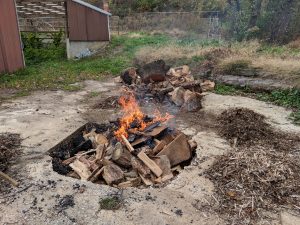We’ve started producing biochar at the farm, primarily for our own use, but if you twist my arm hard enough I’ll sell some as well. You can see our ‘how to’ video produced in October 2020 here:
https://www.youtube.com/watch?v=gBx5ngn9Dpk
I wanted an easy place to refer back to when I forget the recommended ratio to mix with compost for a good biological/mineral/nutrient pre-charge and subsequent application rates. So here it is!
Biochar Application rates:
- Remember that raw biochar will absorb minerals and nutrients in your soil for the first couple of years, nature will correct, so not a big deal but if you want to give your soil and immediate boost, pre-charge your biochar before application
- Easiest way to get it ready for direct application is to mix in when building compost piles
- Mix up to 1:1 or 50% by volume with finished compost and let rest for a couple of weeks before application
- Or up to 1:3 or 33% biochar by volume in unfinished compost for good mineral/nutrient/biological pre-charge of the char before application (higher biochar ratios may shut down your pile)
- Apply pre-charged biochar directly to root zone or in seed furrows at a rate of 1% to 10% biochar by volume of amendments applied.
- If applying bulk, pure biochar directly, go for 1000 to 2000 lbs biochar/acre (raw or pre-charged)
The key to a highly productive, low tech/low cost biochar pit burn:
- Start your fire in the bottom of the empty pit
- slowly add material until the fire just starts to smoke
- let the fire build back up and compact the pile/add more material before any white ash is apparent on any surface
- frequently compacting the burn pile with a heavy poker, crushing coals off and tightening raw wood, really helps final yield
- take care to fill in gaps which might burn too quickly
- if you don’t watch your fire, your char will burn up
- THOROUGHLY quench the fire with water, removing any unburned wood where live coals might be smoldering, and stir the coals until no more steam or smoke is produced
- Let the char cool/drain overnight and dig out into your compost piles.

For our biochar pit (6′ diameter, 4′ deep) it takes about 8 hours to char 6 cubic yards of bulky less than ideal wood. A well tended burn will yield around 250 gallons of char.
Another great, simple way to make char at lower quantities is to use a 50 gallon barrel with no holes and an open top set at a 45 to 60 degree angle. Just build a small fire in the bottom and slowly feed it until it smokes then wait until it starts to ash. Repeat until full, tip it upright and quench with water. Here’s a video of that method:
https://www.youtube.com/watch?v=bNOiVCpRWXw
Best references I’ve come across to develop this process:
- A hard core scienc article on biochar made from rice hulls
Various other biochar links:
- https://www.ithaka-institut.org/en/home
- https://www.biochar-journal.org/en/ct/39
- http://ecofarmingdaily.com/biochar-prepping-soil/
- https://www.terra-char.com/uploads/2/3/7/9/23790961/composting_with_biochar.pdf
- Richar Perkins of Rigedale Permaculture on biochar
- http://livingwebfarms.org/wp-content/uploads/2018/06/Conditioning-Biochar.pdf
- The somewhat long video that goes with the reference above:
http://livingwebfarms.org/multimedia/videos/complete-hands-on-workshops/biochar-inoculation/
- The somewhat long video that goes with the reference above:
- Special Thanks to Dan Hettinger for sharing his experience, references and advice
And if you want to go deep into the science:
- International Biochar Initiative: https://biochar-international.org/
- Science.gov biochar search
- Search on scholar.google.com
- The mother of all biochar history/industrial scale production articles:
Though we haven’t done it yet, I’ve recently (February 2022) learned from Dr. Olivier Husson’s interview on the regenerative agriculture podcast (http://regenerativeagriculturepodcast.com/redox-the-driver-of-soil-microbial-interactions-and-nutrient-availability-with-olivier-husson) that paramagnetic biochar can be produced by soaking your source material in a saturated iron sulfate solution for 24 hours before pyrolysis. I’m looking forward to trying this technique at our farm. Note: this can produce a very acidic biochar (pH around 2.5 at 400 °C, around 6 at 700°C…from direct corespondence with Dr. Husson), so how you inoculate your biochar after production may need to be adjusted accordingly.



